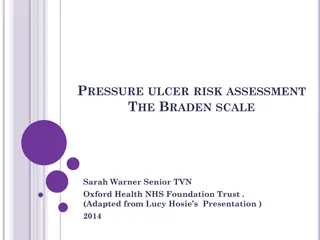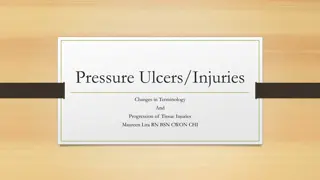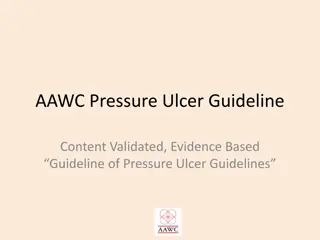Understanding Peptic Ulcer Disease: Causes, Symptoms, and Treatment
Peptic ulcer disease (PUD) involves ulcerations in the duodenal or gastric mucosa caused by factors like Helicobacter pylori infection and NSAID use. Symptoms include abdominal pain and nausea, and treatment often involves H. pylori eradication and proton pump inhibitors to prevent complications lik
1 views • 77 slides
Strategies to Reduce Pressure Ulcers in Hospital Patients
Hospital-acquired pressure ulcers (HAPUs) are a significant issue affecting patient outcomes and healthcare costs. Factors contributing to HAPUs include immobility, comorbidities, and older age. Implementing patient-centered care, evidence-based practices, and quality improvement strategies, as outl
0 views • 18 slides
Peptic Ulcer Disease: Treatment Approaches and Helicobacter pylori Eradication
Common gastrointestinal conditions such as peptic ulcers can be effectively treated through approaches like eradicating H. pylori infection, reducing gastric acid secretion, and using mucosal protecting agents. Helicobacter pylori eradication is crucial for healing ulcers and preventing recurrence,
0 views • 27 slides
Pediatric Dermatological Disorders: Symptoms, Causes, and Treatment
Skin disorders in pediatrics can range from minor issues to serious conditions. Symptoms include rashes, ulcers, dry skin, and more. Understanding the signs, causes, and treatment options is essential for managing pediatric dermatological disorders effectively.
3 views • 35 slides
Understanding Tannins: Properties, Classification, and Medicinal Uses
Tannins are secondary metabolite products with astringent properties, high molecular weight, and various solubility and taste characteristics. They can be classified into true tannins and pseudo-tannins based on the Goldbeater skin test, as well as hydrolysable and condensed tannins based on chemica
6 views • 13 slides
Understanding Infection: Causes, Signs, and Nursing Management
Learn about the definition of infection, common causes, general and specific signs and symptoms, nursing assessment for foot ulcers and pressure injuries, as well as nursing interventions for infection prevention and management. Dive into the stages of infection, general and specific signs and sympt
0 views • 24 slides
Understanding Adverse Events in Clinical Trials
This presentation covers the identification, recording, and reporting of adverse events in clinical trials conducted by University of Edinburgh and/or NHS Lothian. It includes definitions, examples of adverse event recording, SAE form completion, and common mistakes. AEs can range from minor issues
0 views • 35 slides
Association Between Peptic Ulcer and Periodontitis: Insights and Connections
Previous studies have suggested a potential link between peptic ulcer disease (PUD) and periodontitis. PUD affects the gastrointestinal mucosa, with key risk factors being H. pylori infection and NSAID use, while periodontitis is an inflammatory disease affecting the tissues around teeth. Understand
0 views • 17 slides
Understanding constipation, scant feces, and alimentary tract hemorrhage in farm animals
Constipation in farm animals is characterized by decreased frequency of defecation and dry, hard feces. Scant feces are small quantities of feces, commonly seen in animals with stomach abnormalities. Alimentary tract hemorrhage can result from various causes, including ulcers and infestations. Hemor
0 views • 12 slides
Understanding the Sequelae Caused by Wearing Complete Dentures
Denture use can lead to various sequelae, including denture stomatitis, angular cheilitis, flabby ridge, traumatic ulcers, and more. These issues can cause discomfort, destabilization of occlusion, loss of retention, decreased masticatory function, poor aesthetics, and increased ridge resorption. Fa
2 views • 58 slides
Drugs Affecting the Digestive System and Their Functions
This presentation by Dr. Archana covers various drugs that impact the digestive system, such as antacids, intestinal astringents, antiemetics, and more. It explores the functions of these drugs and their roles in treating stomach-related issues like gastritis and peptic ulcers. The chapter discusses
0 views • 20 slides
Understanding Alcohol Misuse in Older Adults
Alcohol misuse in older adults can have serious health consequences, with harmful drinking patterns and alcohol dependence on the rise among this demographic. Aging bodies process alcohol differently, making older adults more vulnerable to its effects, including physical and mental health issues. Al
0 views • 11 slides
Understanding Glanders: Causes, Symptoms, and Transmission
Glanders, also known as Farcy, Equinia, or Malleus, is a contagious disease affecting horses, mules, and donkeys. It is caused by the bacteria Pseudomonas mallei and can be transmitted through direct contact or inhalation. The disease manifests with nodules or ulcers in the respiratory tract and on
0 views • 11 slides
Overview of Bacterial and Fungal Corneal Ulcer
Bacterial and fungal corneal ulcers, known as suppurative keratitis, are a significant cause of blindness, included in national blindness control programs. They result from infections by exogenous organisms like S. aureus, S. pneumoniae, Aspergillus, and Candida. Predisposing factors include trauma,
0 views • 28 slides
Overview of Cutaneous Tuberculosis: Causes, Classification, and Clinical Features
Cutaneous tuberculosis is caused by Mycobacterium tuberculosis and its manifestations depend on the host's immunity, route of entry, and bacterial load. It is classified into exogeneous and endogenous sources, with various types such as tuberculides and tuberculous chancre. Clinical features include
0 views • 31 slides
Anemia in Swine: Causes, Clinical Signs, and Treatment
Anemia in swine can be caused by factors such as gastric ulcers, internal bleeding, and poor nutrition. Clinical signs include pale skin, rapid breathing, and jaundice. Piglet anemia, a highly fatal disease, is marked by decreased hemoglobin levels and liver degeneration. Diagnosis involves examinin
0 views • 11 slides
Understanding Peptic Ulcer Disease and Dyspepsia: Causes and Pathogenesis
Peptic ulcer disease and dyspepsia are common gastrointestinal conditions. Dyspepsia presents with upper abdominal pain and may or may not be associated with peptic ulcers. The most prevalent causes of dyspepsia include non-ulcer dyspepsia, GERD, and peptic ulcers. Peptic ulcers account for a signif
0 views • 24 slides
Understanding Syphilis: Clinical Stages, Diagnosis, and Management
Syphilis, a sexually transmitted infection, presents various clinical stages from primary to late latent. Diagnosed through serological tests like VDRL and FTA, primary syphilis shows painless ulcers, while secondary syphilis exhibits systemic vasculitis with a characteristic rash. Management involv
0 views • 22 slides
Helicobacter Pylori: Characteristics, Pathogenesis, and Diagnosis
Helicobacter pylori is a spiral-shaped Gram-negative bacterium associated with various gastrointestinal conditions like gastritis, duodenal ulcers, gastric ulcers, and gastric carcinoma. It exhibits unique characteristics in common with Campylobacters and has specific culture and growth requirements
0 views • 5 slides
How To Cure Mouth Ulcers Fast Naturally at Home
Discover easy-to-follow home cure for mouth ulcers. Learn how you can find relief without leaving your kitchen. Say goodbye to mouth discomfort naturally.
1 views • 10 slides
Overview of Sexually Transmitted Diseases (STDs): Causes and Laboratory Diagnosis
Sexually transmitted diseases (STDs) encompass a variety of communicable infections transmitted mainly through sexual contact, caused by a diverse range of bacterial, viral, protozoal, and fungal agents. STDs can manifest as genital ulcers, discharge, or systemic symptoms. This article highlights di
0 views • 18 slides
Understanding Peptic Ulcers: Causes, Symptoms, and Treatment
Peptic ulcers are open sores that form in the stomach or upper small intestine, leading to symptoms like stomach pain, bloating, and nausea. Common causes include H. pylori infection and NSAID use. Recognizing symptoms, such as burning stomach pain, is crucial for timely diagnosis and management. Se
0 views • 19 slides
Understanding Foot Pathologies: Traumatic Injuries and Pressure Injuries
Explore common foot pathologies including traumatic injuries like plantar fasciitis, turf toe, and sprains, as well as pressure injuries such as plantar ulcers and heel spurs. Learn about the causes, symptoms, and treatment options for these conditions.
0 views • 33 slides
Understanding Aquatic Epidemiology in Fish Populations
Aquatic epidemiology is a crucial branch of science that focuses on describing the health, diseases, and welfare of fish populations. It involves studying diseases in wild and hatchery-raised fish, identifying factors influencing disease occurrence, and conducting diagnostic investigations to mainta
0 views • 12 slides
Understanding the Diabetic Foot: Stages, Assessment, and Management
Explore the natural history of the diabetic foot, from initial stages to potential complications like ulcers and infections. Learn about the assessment of ulcerated feet, including identifying signs of infection and necrosis. Discover the role of radiography and microbiological control in managing d
0 views • 51 slides
Safety Measures for Using Concrete in Construction Projects
Concrete is a commonly used material in construction projects, but it comes with risks to health. Wet cement can cause serious burns or ulcers on skin, as well as chemical burns to the eyes. Proper precautions such as wearing appropriate PPE, controlling exposure, and safe handling techniques can he
0 views • 6 slides
Understanding Pressure Ulcer Risk Assessment with the Braden Scale
Pressure ulcer risk assessment is crucial in healthcare settings to identify individuals at risk of developing pressure ulcers. The Braden Scale, developed in 1984, evaluates six key elements contributing to pressure ulcer development. It provides a standardized method for assessing risk levels base
0 views • 20 slides
Understanding Peptic Ulcers: Causes, Symptoms, and Nutritional Management
Shahid Virpatni Laxmi Mahavidyalaya conducted a presentation on gastrointestinal (GI) disorders, focusing on peptic ulcers. The content covers the etiology, symptoms, and nutritional management of peptic ulcers, emphasizing the importance of proper diet in managing this condition. Peptic ulcers, cha
0 views • 8 slides
Understanding Leishmaniasis: Types, Symptoms, and Treatment Options
Leishmaniasis is a parasitic disease caused by Leishmania parasites transmitted through infected sand flies. It comes in three forms - cutaneous, mucocutaneous, and visceral - each with distinct characteristics and treatment approaches. Cutaneous leishmaniasis causes skin ulcers, mucocutaneous affec
0 views • 32 slides
Overview of Stomach Surgery and Treatment Options
The stomach plays a crucial role in digestion and is divided into four regions - cardia, fundus, body, and pyloric part. Understanding the anatomy of the stomach is essential for surgical interventions, including treatment for benign and malignant gastric diseases like peptic ulcer disease. Surgical
0 views • 30 slides
Understanding Peptic Ulcer: Symptoms, Diagnosis, and Treatment
Peptic ulcers are holes in the gut lining of the stomach, duodenum, or esophagus. This condition can present with symptoms like upper abdominal pain, bloating, and dark stools. Risk factors include smoking, stress, and certain medications. Diagnosis involves various tests, and treatment includes ant
0 views • 15 slides
Understanding Peptic Ulcers: Causes, Prevalence, and Treatment
Peptic ulcers are circumscribed ulcerations in the gastrointestinal mucosa, commonly caused by Helicobacter pylori infection. They have a higher prevalence in developing countries and are associated with factors like socioeconomic status, poor hygiene, and genetic links. While peptic ulcers naturall
0 views • 54 slides
Understanding Diabetic Foot Ulcers: Causes, Types, and Treatment
Diabetic foot ulcers are a common complication among diabetic patients, leading to disability and hospital admissions. The ulcers can be caused by factors like neuropathy and ischemia. Identifying the types, such as neuropathic and ischemic ulcers, helps in determining appropriate treatment, which m
0 views • 12 slides
Understanding Pressure Ulcers and Tissue Injuries Progression
Pressure ulcers, also known as pressure injuries, are localized damages to the skin and underlying soft tissue usually over bony prominences. The National Pressure Ulcer Advisory Panel changed the terminology in 2016 to classify all stages as injuries, not just ulcers. Stages range from non-blanchab
0 views • 13 slides
Understanding Pressure Sores and Preventive Interventions for Bedridden Patients
Pressure sores, also known as pressure ulcers, are localized areas of tissue necrosis caused by prolonged pressure on skin and soft tissues. This can lead to serious complications, especially in bedridden patients like a 76-year-old man following a stroke. Preventive interventions include relieving
0 views • 26 slides
Bridging the Information Gap Across the Care Continuum: A Team Approach
Addressing the importance of effective information transfer in healthcare transitions, this article highlights a team-based approach to prevent skin breakdown and pressure ulcers during care transitions. Through group meetings, problem identification, resolution timelines, and accountability, the fo
0 views • 11 slides
Understanding Bacterial Diseases of Fish
Bacterial diseases such as Haemorrhagic Septicemia can affect fish, causing symptoms like haemorrhaging, skin ulcers, and abdominal haemorrhages. These diseases are often linked to environmental factors like overcrowding, pollution, and warm water temperatures, and can lead to significant mortalitie
0 views • 17 slides
Understanding Barium Meal Radiological Study
Barium meal is a radiological study of the upper gastrointestinal tract, including the esophagus, stomach, duodenum, and proximal jejunum. It helps diagnose various conditions such as peptic ulcers, cancers, and gastrointestinal obstructions. The procedure involves oral administration of barium cont
0 views • 11 slides
Facility Improvement and Program Audit in Oklahoma Healthcare
The data showcases quarterly performance percentiles and quality measures in Oklahoma healthcare facilities, highlighting changes in anti-psychotic medication, pressure ulcers, urinary tract infections, and excess weight loss. Furthermore, program audit outcomes reveal common trends such as high tur
0 views • 4 slides
AAWC Pressure Ulcer Guideline: Managing Pressure Ulcers Effectively
This content outlines the AAWC Pressure Ulcer Guideline, providing evidence-based recommendations for assessing, preventing, and treating pressure ulcers. The guideline emphasizes the importance of regular skin assessment, personalized care plans, and interdisciplinary wound care management to impro
0 views • 15 slides







































